| I cannot claim authorship of the piece reproduced here, though I did contribute to its composition under the pen of Peter Wootton Beard. It recently appeared as a tribute from the Vice Chancellor, Elizabeth Treasure, in the inboxes of all university staff. John Corfield was ubiquitous in Aberystwyth, some knew him best for his work at the exceptionally fine gardens of the Penglais campus, others for the panache with which he received bucket loads of wallpaper paste down the trousers in the Wardens’ pantomimes. I reproduce the tribute here in full, but have augmented it with a number of photographs charting his life. It is with a heavy heart that I share the news with you that our former Head Gardener John Corfield passed away peacefully on 15th August 2020. He will be hugely missed. John was born shortly after his parents moved from Montgomeryshire to Tan-y-Castell farm, Llanfarian in 1933, where his father became the tenant farmer of the Tan-y-Bwlch estate. After a terrible flood in 1964, the family were forced to leave the farm and moved to Marian House, Llanfarian. 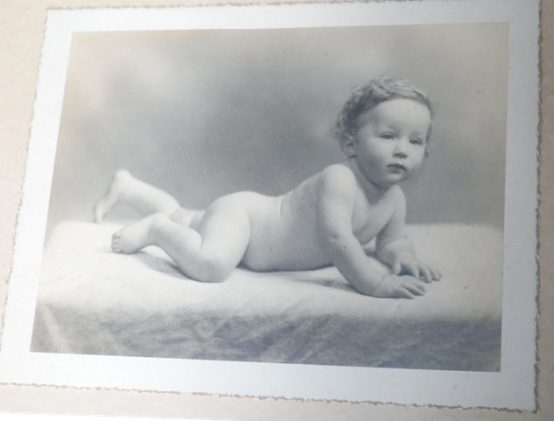 John Corfield. Portrait by H.N. Davies of Aberystwyth 1934 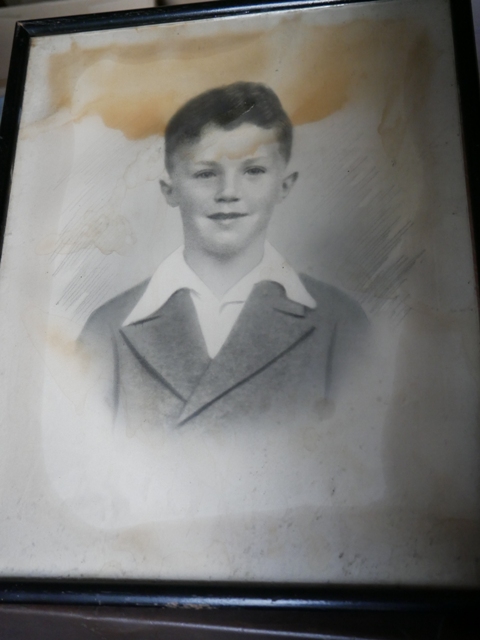 The schoolboy John, in a photograph re styled as a pencil drawing John subsequently joined the University staff under the newly appointed Curator of the Botany Gardens and College Grounds, Basil Fox, and under the direction of Prof. Philip Wareing, then Head of Botany shortly thereafter. The team were responsible for taxonomic order beds adjoining Plas Penglais, the provision of plants for the undergraduate practical classes and research programmes, as well as the management of small-scale field experiments for the Botany and Agricultural Botany departments of University College Wales. Their role expanded to include the planting of the new Penglais Campus. The campus rapidly expanded over the next twenty years and between them, John and Basil were responsible for introducing a wide range of plants that are perfectly suited to the exposed coastal conditions. John became Head Gardener in 1983, amply filling the rather large shoes vacated by his predecessor, Basil Fox. The gardens were highly praised by Arthur Hellyer in the 1970s and were awarded a Grade II listing in the Cadw Register of Landscapes, Parks and Gardens of Special Historic Interest in Wales in 2002. The listing describes them as ‘One of the most important modern landscaping schemes in Wales’. John worked with the renowned landscape designer Brenda Colvin overseeing the planting between Pantycelyn and the main campus and was instrumental in bringing her vision to fruition. It is perhaps a little known fact that we work in such a special landscape, but I’m sure we all appreciate the beautiful surroundings that greet us when we come in to work, and we have John to thank for much of that. The current grounds team, under the management of Jeff Saycell, are working hard to restore elements of the original landscape and to protect John’s legacy. John became a formidable botanist; whose breadth of knowledge and interests were honed on his many botanical excursions with friends and colleagues to locations such as Greece, Crete, and the Pyrenees. On such occasions he demonstrated his considerable skill with languages, regularly surprising people with his ability to get about comfortably in Greek, Turkish, German and others.
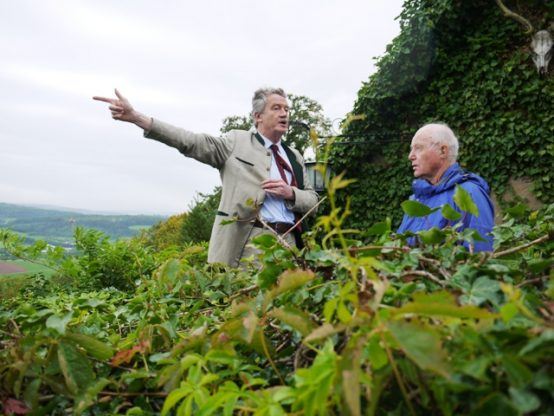 In Germany with Count Constantin von Brandenstein
His expertise was often called upon for the student trips organised by the Botany department to the Picos de Europa mountain range in Cantabria, Northern Spain. His colleagues at the time describe John as a ‘magnet’ for students during these 8-10 day trips under canvas, due to his vast botanical knowledge, patience and warmth of personality. 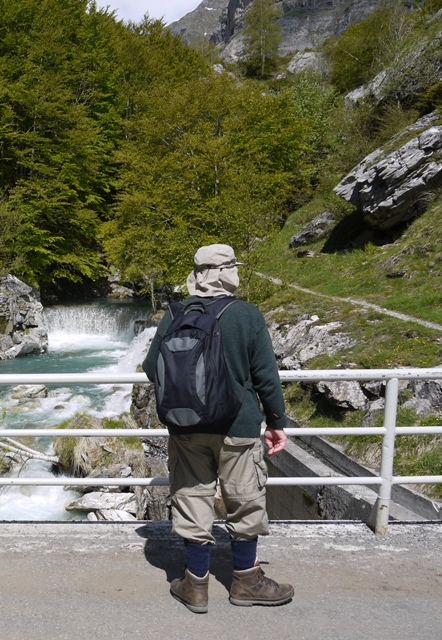 In field gear in the Pyrenees Maintaining academic standards in this environment required considerable ingenuity, and John was a great source of strength – making camp furniture, mentoring projects and monitoring student submissions. He was able to form a connection with anyone and everyone he met and inspired a generation of botany students. He wrote to his friend and former colleague Andrew Agnew just eight days before his passing to reminisce about how much he enjoyed the trips to the Picos de Europa, a memory that Andrew was pleased to share. He was also often called upon to share his passion through talks and practical advice to the local community. 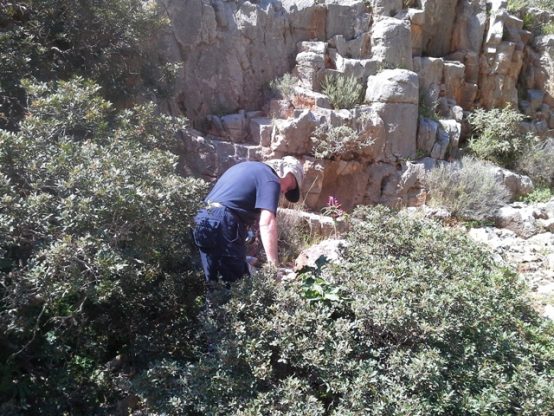 Botanizing in Crete 2015 He was a founder member of the Cardiganshire Horticultural Society, formed in 1968, and following Basil Fox’s death in 1983, became the second President of the society, a post he filled until its 50th anniversary in 2018. Today the society has over 150 members, a tribute to the energy and warmth that John brought to every meeting. 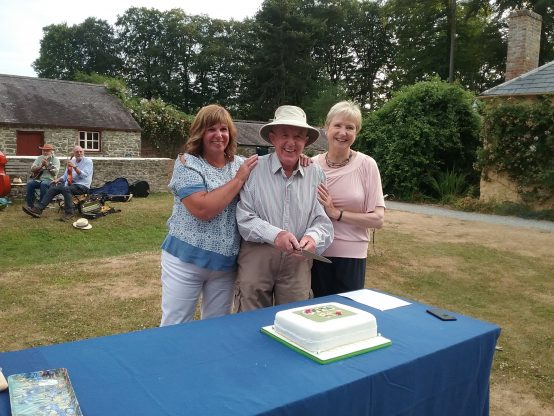 The Cardiganshire Horticultural Society turned 50 in 2018. President John Corfield with Jan Eldridge and Kay Edwards who helped cut the cake. So many members of the society have plants given by John in their gardens, and he was well known for his generosity that would lead him to lovingly raise seedlings at his home, with the express purpose of bringing joy to those who would subsequently receive them as an impromptu gift. He had just told me that he was growing a Koelreuteria paniculata (Golden Rain Tree) for me at the time of his passing, and I can think of no better way to remember him. Prof. Mike Hayward remarked that a cyclamen grown for him by John came into flower on the day of his passing, a lasting gift that so many of his friends will be able to enjoy for years to come. John was also a keen thespian and a founder member of the relaunched ‘Wardens Amateur Dramatic Society’. He was involved with nearly every show since the early 1980s as, variously, stage management, performer & front of house. He was also involved in many productions by Showtime Singers. 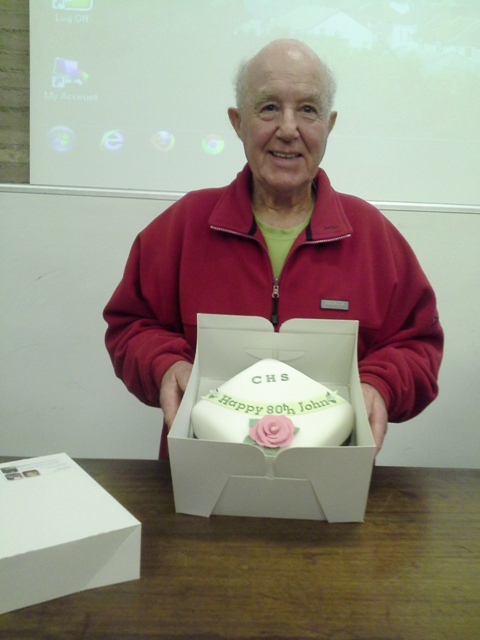 The Cardiganshire Horticultural Society celebrated their President’s 80th birthday in 2013 A private funeral took place at John’s green burial on 27th August, where only a small number could be present due to Covid-19 restrictions. We hope to celebrate John’s life in fitting style in due course within the Horticultural Society, and I will circulate details of any subsequent event for staff/former colleagues who may wish to attend nearer the time. We also hope that a memorial tree for John will soon be planted on the campus, details of which will be shared in due course. Thanks to John’s friends, family and former colleagues for their help in preparing this tribute: Tom Corfield, Matthew Piper, Dr Andrew Agnew, Pat Causton, Margaret Howells, Prof. Mike Hayward, Dr Caroline Palmer, Dr Edwina Ellis, and Penny David. My thanks to Dr Peter Wootton-Beard for his working in preparing this wonderful piece in memory of John Corfield. Professor Elizabeth Treasure |
Category Archives: Ceredigion present
Justina Jeffreys – Black History
By The Curious Scribbler
During the ennui of lockdown I have been researching a little piece of Ceredigion’s black history.
My subject was Justina Jeffreys of Glandyfi castle, that eccentric Regency Gothic castle which perches above the (now straightened) Glandyfi Bends on the way to Machynlleth. It was built in 1818 as the fashionable designer home of Shrewsbury born lawyer George Jeffreys and his new bride Justina Scott. Justina had grown up at Bodtalog, a small country house near Tywyn, as the child of the bookish intellectual Edward Scott and his wife, the widow Louisa de Saumaise. It has long been believed that she was the model for Anthelia the heroine of Thomas Love Peacock’s first novel Melincourt. Anthelia is described as a highly rational young woman brought up and educated in solitude by a man of ‘great acquirements and of a retiring disposition’.
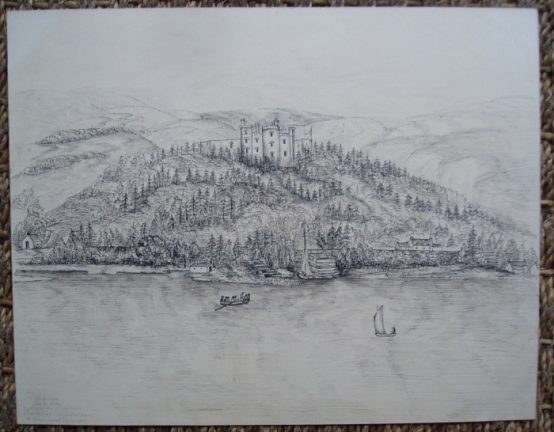
Glandyfi castle sketched by Francis Wood in 1838
But all was not as it seems, for Justina was not born a Scott. She was born in Jamaica in 1787 the daughter of the premier army man then posted to the island, Captain Charles McMurdo of the 3rd East Kent Regiment “the Buffs” and a young woman called Susan Leslie. In the eighteenth century colonies bastardy was a very common phenomenon, on most pages of the parish birth records the children born in wedlock are the exception rather than the rule. I cannot believe that the church actively approved of this situation but its clergy were diligent in recording the facts. Fathers are normally named, and race and status was a matter of record.
So we know that Susan Leslie was a free mulatto, who underwent baptism in the Anglican church at the same time as her new daughter. A mulatto is a specific term, it means she had one black parent, and given the social structure of the slave economy it is highly likely that that black parent was a woman and a slave.
Justina’s conception was more than a one night stand, for two years later her brother was born, also sired by Captain McMurdo, and named Charles McMurdo.
There might have been more illegitimate McMurdos were it not for the fact that Captain McMurdo’s posting in Jamaica came to an end, and he was sent off to Canada, where he eventually married a well connected young woman from a loyalist family, named Isabella Coffin and started a second family. His first legitimate son was named Charles Alured McMurdo (the unusual second name being a nod to the Governor of Jamaica, Alured Clarke under whom McMurdo had served).
Susan Leslie remained in Jamaica, and must, I believe, have been a handsome and sought-after young woman. She was soon the partner of a Scottish doctor, John Wright by whom she had two more sons. She was, or in her lifetime became, a woman of property for her will, written on a visit to London in 1801, distributes her land, buildings and slaves among her three sons, and names both the fathers as executors of the will.
It is touching that in the will she leaves to Justina her ‘apparel, trinkets and her silver spoons’. In a subsequent codicil she rescinds these small gifts because her daughter has been amply provided for by McMurdo. So how had McMurdo provided?
Justina had been removed from her mother and ‘adopted’ by Edward Scott, who during the Jamaica years had been Captain McMurdo’s junior officer, First Lieutenant in the same regiment. Edward, an impecunious younger son of an aristocratic Kent family had no children of his own, but when Justina was just three years old he had married, possibly for money, the wealthy widow Louisa, who happened to be the widow of his first cousin Count Louis de Saumaise. It was through Louisa, daughter of welshman Lewis Anwyl, that he winded up living comfortably as the squire of Bodtalog with Louisa and Justina. I would speculate that when Justina was five or six years old she was shipped off to her new ‘uncle’. She must have been quite young to have been so well educated and nurtured as a Welsh gentlewoman, but not so young that her brother Charles did not remember her. While there is no evidence that the siblings met again, by the age of 20 Justina’s brother Charles McMurdo was in Limehouse, London founding a family of several generations of boat builders. He and his descendants repeatedly named their daughters Justina.
Although Justina is named as Justina Scott in the marriage register her paternity was no secret, it was known to the Jeffreys family into which she married, and her birthplace, Jamaica, is recorded in the census. Her high-status white father, McMurdo, would have been a matter of pride rather than shame, just as Mary Seacole, who we now venerate for her blackness, was openly proud of her Scottish military father. Justina’s story reminds me of other examples of the rapid social mobility of the mixed race offspring English and Welsh gentlemen in the eighteenth century. The purchaser in 1803 of the Piercefield estate near Chepstow, for example, was Nathaniel Wells the Jamaican-born natural son of William Wells, his offspring by a house slave known as Juggy. Nathaniel’s origins did not hold him back, he became the high sheriff of Monmouthshire.
George and Justina seem to have enjoyed a nice life in their pretty castle, and produced eight children all baptised at Eglwysfach church, where her old admirer Thomas Love Peacock also showed up to marry Jane Gryffydh in 1820. Justina’s relationship with her adoptive parents also seems to have been good, two of her children bear the names Edward and Louisa, and when the very elderly Edward Scott eventually died aged 90 his estate, barring various legacies, was placed in trust for Justina for her lifetime.
Glandyfi castle first went on the market in 1906 when it was sold by two of Justina’s granddaughters. Several lines of descent from George and Justina have been extinguished in later generations, but some persist in New Zealand and America, and have been known to turn up on holiday to visit the castle. Today it is for sale once more for £2.85million.
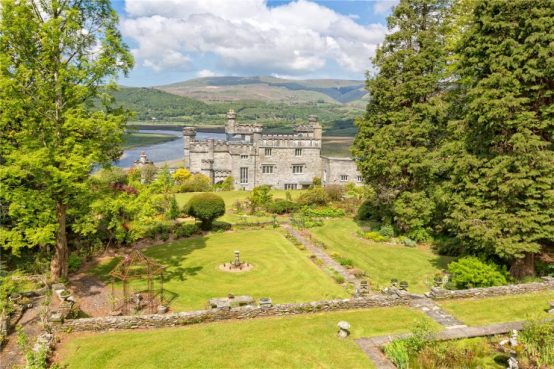
Glandfi Castle sale particulars in Country Life 2020
The full story of my researches have been accepted for publication in Ceredigion, the Journal of the Ceredigion Historical Society and will appear in 2022.
A perfect day for Pendinas
By The Curious Scribbler
It is hard to remember last week’s grey shrieking storm. Yesterday I walked up Pendinas in balmy sunshine, and a gentle breeze. The sea looked as blue as the Mediterranean and the recently turbulent ocean is now calm and translucent – one can see the dark shadows of clouds upon the water, but also the shaded blotches of underwater outcrops of rock under the sea. Looking over towards Alltwen, the black cattle were all grazing on the flat land. Some mornings they are spread right up the hillside above the woods which enfold Tanybwlch mansion. There is a grandeur in seeing the cattle spread out like wild things in this huge landscape, not penned in a modest field of monocultural grass. The flats are no longer the scene of the trotting races, but viewed from Pendinas one can still see the ghost of the grass track, subtly darker, perhaps better fertilized, than the rest of the meadow.
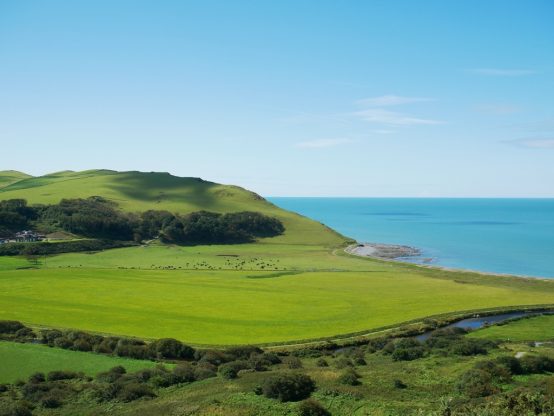
Alltwen and the Tanybwlch flats viewed from Pendinas
The climb is a prolonged one, even from the ‘easy’ access at the top of Cae Job in Penparcau. Families toiled up the path to the iron age hillfort, topped with Victorian arrogance by the chimney-like monument to Wellington’s victory at Waterloo.
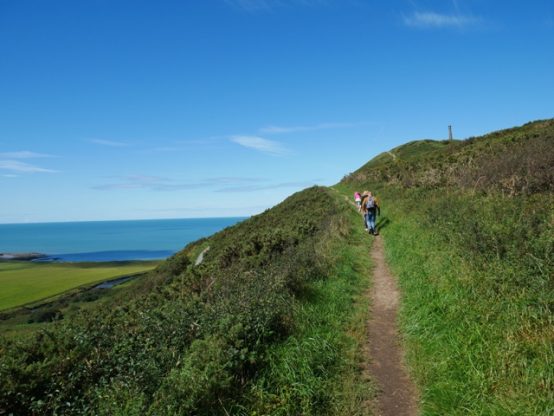
The path up from Cae Job
At least that is what it ostensible is. Personally I think of it more as a monument to a local gentleman, William Eardley Richardes of Bryneithin Hall who built it in 1856 and invited subscriptions from the town. It is no coincidence how grandly it adorns the landscape as viewed from the windows of his mansion to the south. The victory at Waterloo was in 1815, and I would have thought that by 1856 national fervour for a monument would have somewhat abated. Richardes himself had been in the army of occupation after Waterloo, and was moved to re-name the five fields around his house General, Governor, Captain, Lieutenant, and Major! They appear thus on the tithe survey of 1848.
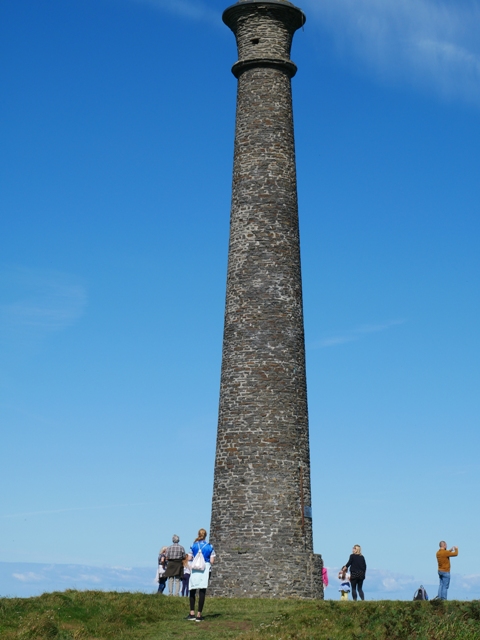
The wellington memorial on Pendinas
There were quite a few people at the top, typically facing in all different directions! The 360 degree panorama laid out before us has no weak point. Take your pick for views of the harbour and the sea and the distant Lleyn Peninsula, Penglais Hill punctuated by the Hospital, the National Library and University of Aberystwyth, or Penparcau spread out around its green-roofed 20th century primary school.
I first sat on the seaward side, where the bracken and gorse given way to heather and coarse grass. A wren fidgeted around a dead tree stump below me, and the honey bees came in waves, sometimes there were none, then quite suddenly thirty or more were working their way through the flowers beside me, then disappearing back to the hive. This is a great spot for looking down on flying birds: red kite, herring gulls, soaring the thermals, crows sculling steadily across the fields. Four speed boats came south into my view leaving white trails of wake. When they gingerly slowed to creep into Aberystwyth harbour at low tide I could see underwater the bar which partly occludes the harbour mouth.
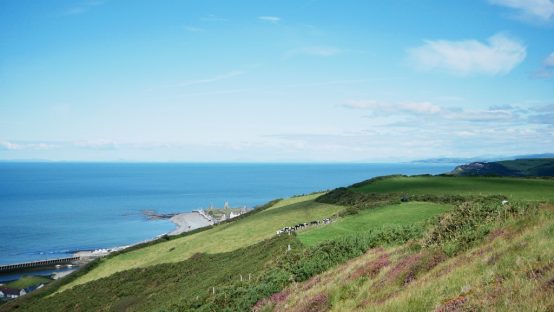
Aberystwyth Castle just visible from Pendinas
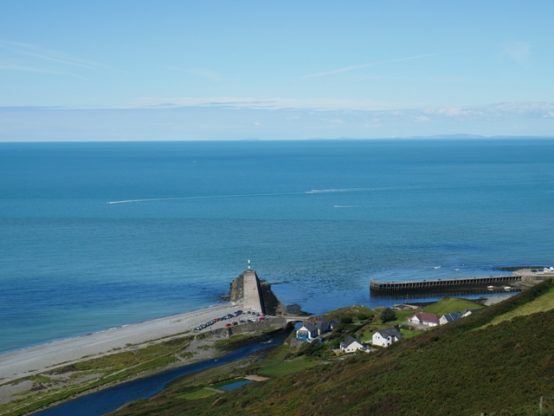
Speedboats approach Aberystwyth Harbour
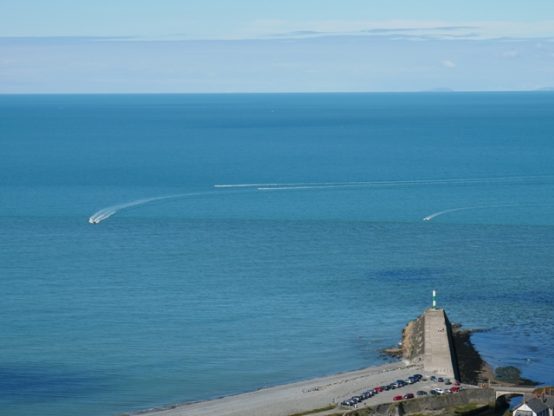
It may be a Bank Holiday during a pandemic but there is space and beauty for all to enjoy. Looking down, one could see around twenty cars parked at Tanybwlch beach now that the concrete barriers have been cleared away. There has always been more than enough space for social distancing on that beach, and I am glad to see these unnecessary restrictions have been removed.
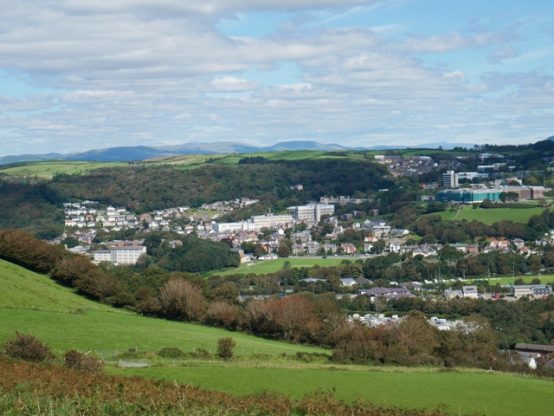
Penglais Hill, Aberystwyth, viewed from Pendinas
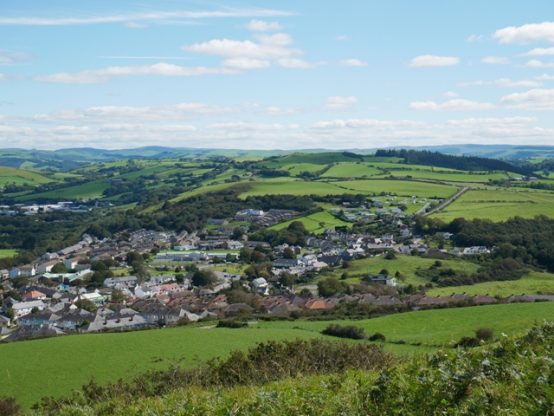
Penparcau, viewed from Pendinas
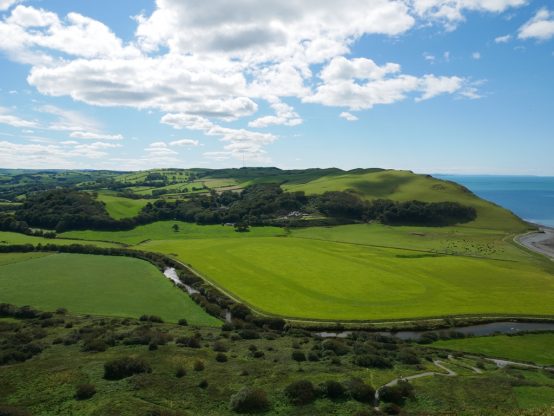
The view south from Pendinas
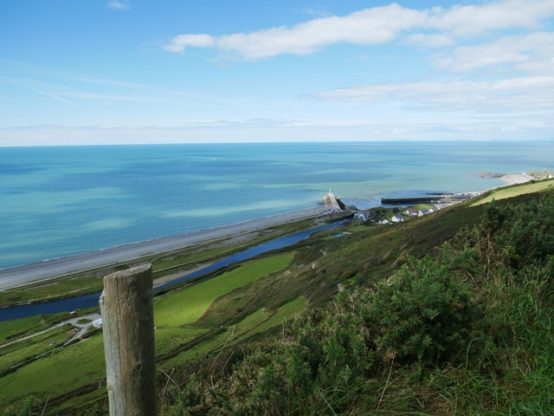
The Ystwyth enters the harbour at Penyranchor
I love a storm!
by The Curious Scribbler
Rain last night has further swollen the rivers, and now we have wind! Exhilarating buffeting winds from the west, gusting almost hard enough to knock you over! 60 miles an hour or so I’m told. So my place of choice is Tanybwlch, where the Ystwyth debouches into the sea. It is murky and brown with fresh run off, and further swollen in the tidal reach because the tide is obstructing its outward flow.
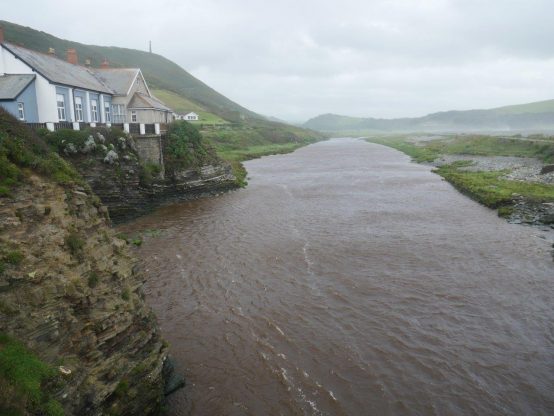
High seas back up the Ystwyth river
Mist from the breakers hangs over the Tanycastell fields and the riverside path is flooded in parts.
The concrete jetty largely protects the harbour mouth, though the swell still forms regular brown rollers creeping along its leeward side.
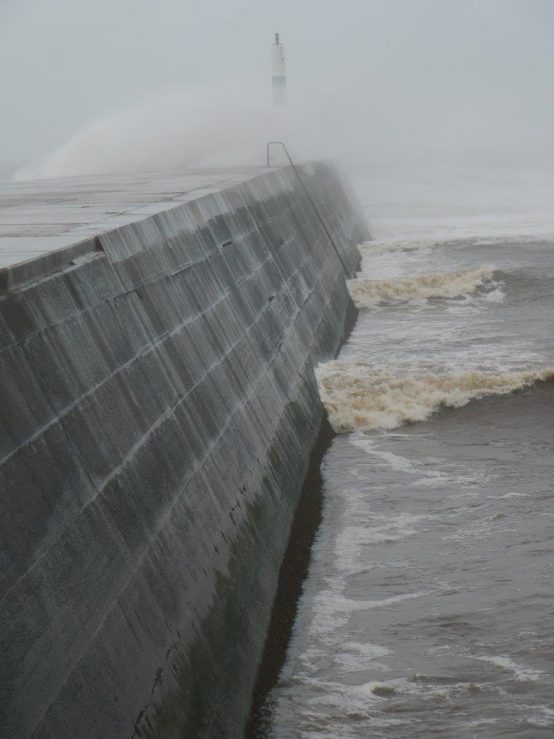
The stone jetty protects the harbour from the south westerlies but some waves roll in
But to position yourself on the windward side on the top of the shore provides an endless spectacle, as waves break in curious explosive shapes over the green and white harbour marker, sometimes obscuring it from view, and the backwash forms swirling wave patterns in the angle between the beach and the shore. It is easy to see how the huge stones at this end of the beach get their smooth contours. The sea acts like a giant pebble-polishing device.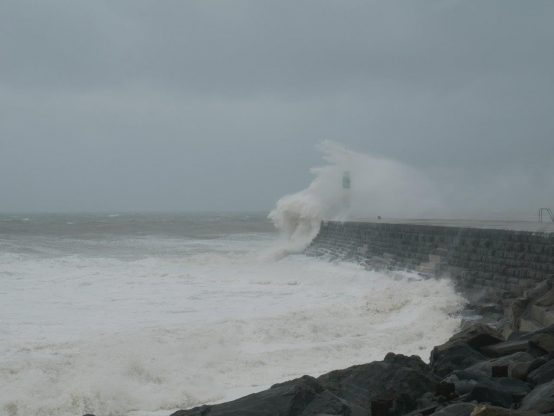
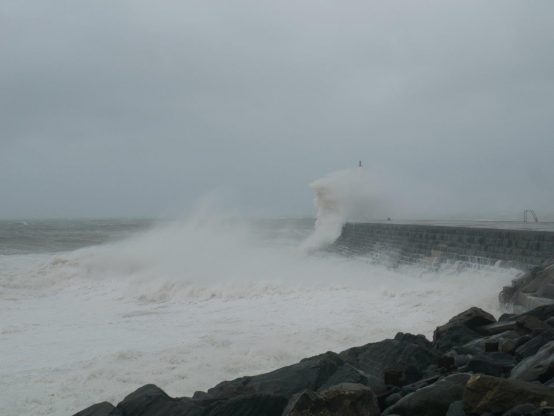
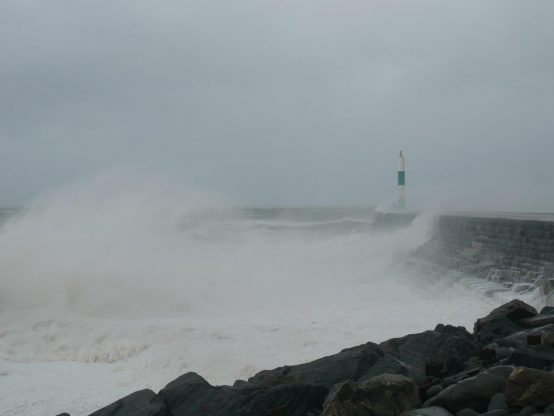
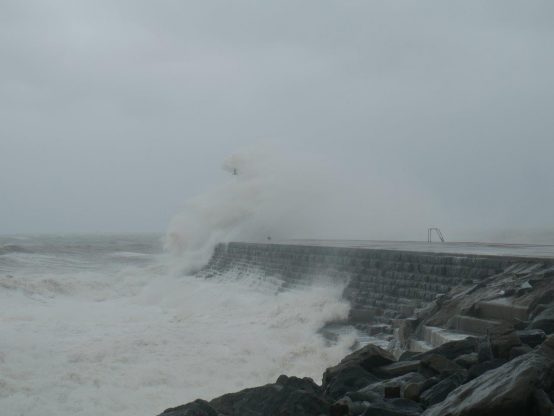
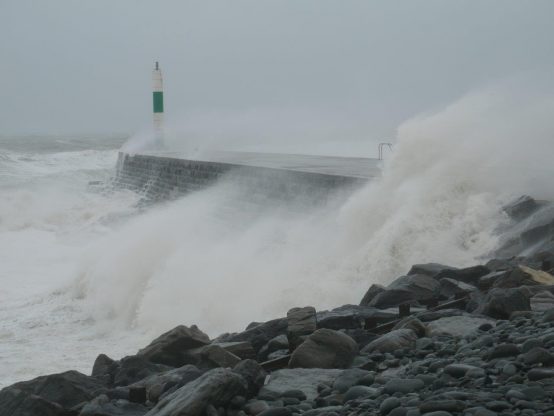
Waves breaking over the stone jetty
The town is a little tamer than Tanybwlch, but still dramatic. At 4pm the clouds were so dark that the streetlights on the prom were glimmering into light.
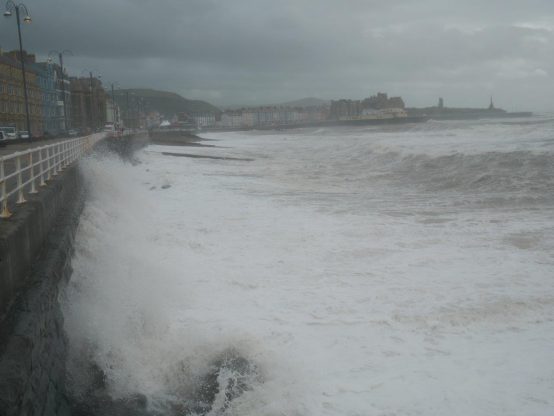
The Promenade takes a battering
Unwary promenaders could get splashed by the waves curling up against the sea wall and showering spray and small pieces of gravel. As the waves pull back the perfect profile of the sandy beach is briefly exposed.
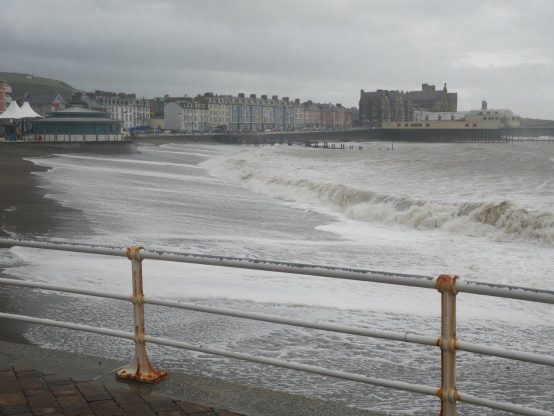
Sand is smoothed out as the big waves flow back into the sea
The full force of the open sea is greatest at Alexandra Hall but this was a summer storm, not one of the ferocious winter ones which sometimes hurl stones at the windows of that forbidding building. The door was open and without barricades. Students will soon be moving in again. There were a few walkers kicking the bar, and beyond it the small piece of sandy beach below Constitution Hill was white with blown sea foam.
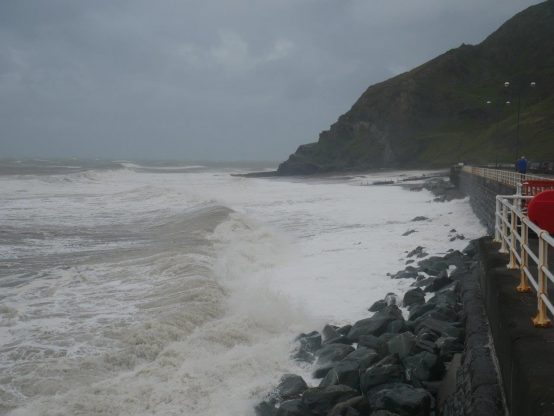
The north end of the beach
I came home to wash the sea salt out of my hair, much invigorated by the wind and waves.
Upfest at Tanybwlch?
by The Curious Scribbler
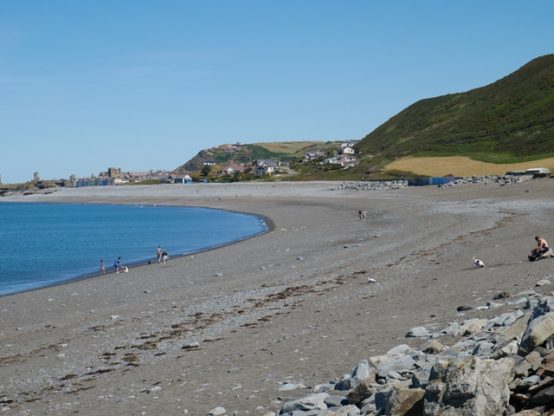
Tanybwlch beach, looking north to Aberystwyth
Inspired by the video I described in the preceding blog, I walked Tanybwlch beach again yesterday, enjoying the blazing sun and balmy breeze. The sea was almost waveless, clear and the deepest blue, and the shore, as usual, was almost deserted. I saw a family at the water’s edge, and a couple of people walking their dogs, and I passed one man who was seated watching his three terriers each of which was energetically digging its own hole in the sand. The sea, cracked only by a single ripple approaching the shore, looked like shot silk.
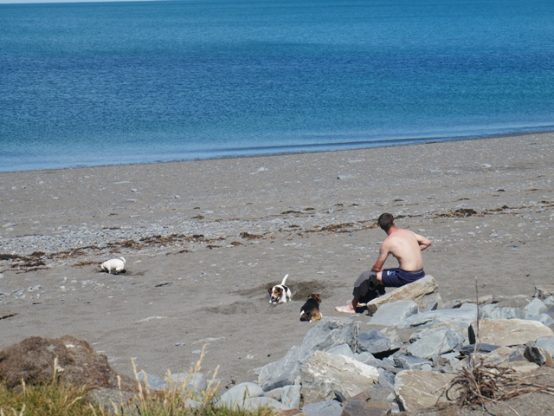
Three digging dogs
The graffiti artists on the concrete sea wall have been back and have further embellished the design which appeared on the drone video I had watched. The letters NHS are no longer brutalist boxy letters, now sporting serifs and curliques of a playful nature. The seated figure, on closer inspection, is a dead-eyed Boris debating whether or whether not to save the NHS. To the right are a series of weird heads, two gowned and masked blue front-liners, and then a group perhaps the public, some in outline, one with a covid mask. There is more wall yet to be painted, I think there is more work to be done there.
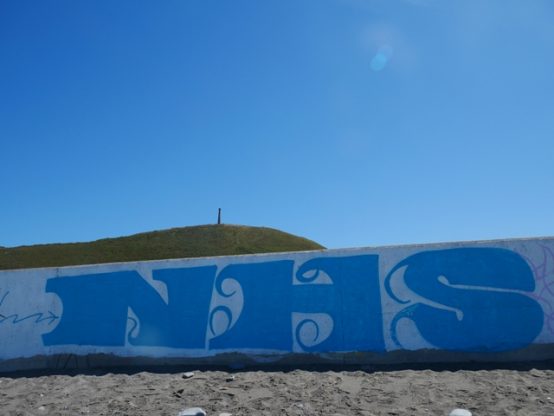
Graffiti at Tanybwlch beach
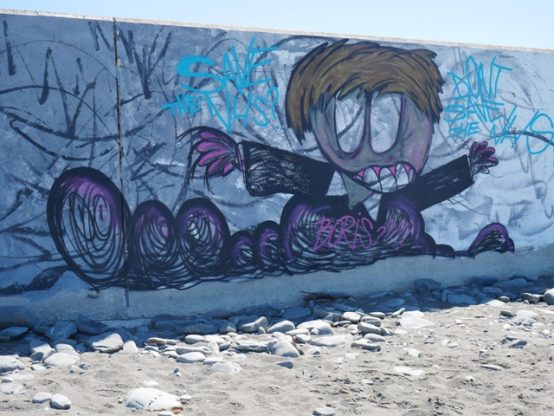
Graffiti at Tanybwlch beach
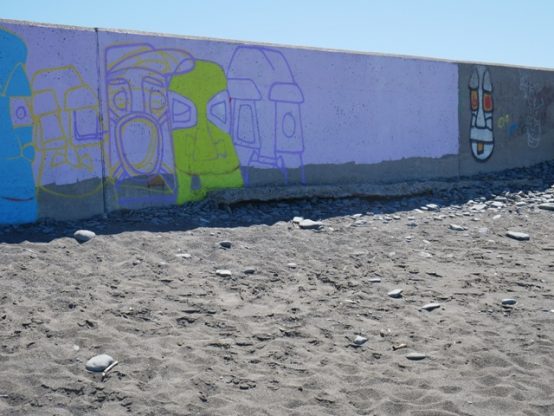
The right-hand end of the mural, yet to be coloured in?
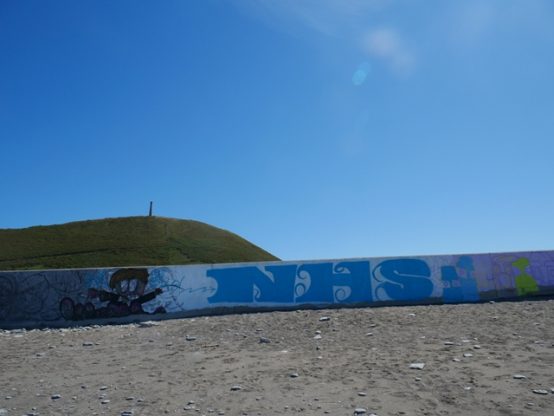
The whole mural at Tanybwlch beach, possibly yet to be completed
It seems surprising now, that no-one has formerly set about embellishing this long wall. Here is a canvas comparable with some of the large murals created for the Upfest Festival in Bristol, and like many of those, it is on a topical theme. I have just noticed that the latest Upfest, which brings together British and international artists, was scheduled to take place this weekend, 30 May- 1 June 2020. I presume that like everything else, it has been postponed, though this is not confirmed on their website.
This blog has previously reported from Upfest, and I hope to go again.
Tanybwlch – A Historic Video
by The Curious Scribbler
Day 67 of lockdown – the days have become a bit of a blur. Like a soothing nature programme, the past two months have been generally beautiful, with startlingly clear skies, lovely wildflowers, continuous birdsong. Too continuous even, I sometimes wish that the monotonous chiffchaffs would give it a rest.
My walks start from my front door, and lead me to Tanybwlch beach, Pendinas, Penparcau and Llanfarian along the footpaths and cycle paths. I am so fortunate to have such an amazing landscape within easy reach. Today I found a newly posted video on You Tube named Aberystwyth in the SKY Tan Y Bwlch which gave me great delight. Here is a tranquil 4 minutes of a birds-eye view of my entire domain, shot during lockdown on one of the many still days when the sea barely sucks at the shore, the sun blazes down, and people, so few and far between, are visible here and there. There are no cars in the Tanybwlch car park (a consequence of the concrete roadblock erected in late March), no contrails in the sky. We may look back with nostalgia on this creepily empty scene when normal life is resumed.
I am pleased that the photographer has briefly included a child and a dog, (presumably his or her own) enjoying the shore. Children have been out and about far too little during lockdown. Joggers and cyclists have made the most of their freedoms, but to spy a child has been a rare sight on my walks. Hopefully today’s announcement will empower more families to take their children out on our beaches.
At the very end of the film is the briefest glimpse of a huge new graffito on the concrete barrage where the Ystwyth turns northwards. The brutalist blue capitals contrast with the human depicted on the left, a figure more typical of the ethos of the beach.
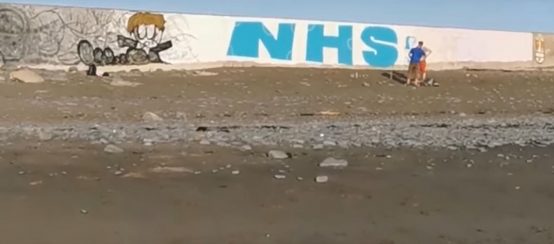
A screen grab from the video
It would be very visible from the sea: were anyone out there to view it.
Footpath is open at Penparcau
By The Curious Scribbler
I am delighted to learn that I am in error, and that last week I quite needlessly climbed over a gate ( as described in yesterday’s blog). The gate in question was on the footpath across the flank of Pendinas, which emerges at the Cae Job gate to Penparcau.
I had let myself through the gate on Felin y Mor and onto the seaward end of the path, by means of lifting the little latch on the gate with my gloved hand, in accordance with best practice. At the Cae Job gate I failed to open it, and finding the latch immobilized with a cable tie, I believed it to be locked. Several readers have today informed me that the cable tie in fact immobilized the catch in the open position!
I am grateful to learn this and hope others will not be discouraged from taking the path. The purpose of the cable tie, I learn, was to allow the gate to open at a push (or a pull), without need to touch it. I don’t know why it didn’t then swing open when I began to climb it, but the good news is that the path is not closed. The route through the fragrant gorse, with its attendant stonechats, chiffchaffs, dunnocks, linnets and wrens is a delight. Violets, primroses and stitchwort flank the path, and a thirsty dog can pause at the well beside the ruined remains of the cottage which formerly stood on the long slope towards the sea.
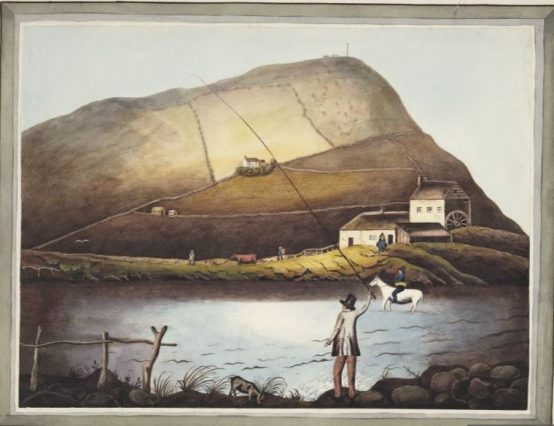
‘The Welsh Primitive’ (active 1830-1853) painted the cottage beside the path, half way up Pendinas. National Library of Wales, Drawing Volume 56.
I find that a massive 1400 people read yesterday’s Letter from Aberystwyth, when it was flagged up in the You Know You’re from Aberystwyth When group on Facebook, and the comments there were many and varied. Some feel as I do, while others feel that I should stay home and shut up! A disputed theme concerns the blocking of car parks such as that at Tanybwlch beach. Last week, the Government clarified that it was acceptable to drive locally to access a suitable place to walk: the guidance being that one should not drive long distances to take a short walk. It remains the case that at present many people feel intimidated to travel even a mile by car to enable them to walk safely in an agreeable open space. I am indeed fortunate to have all this landscape within walking distance from my home.
Enjoyment is frowned upon!
by The Curious Scribbler
The last time I walked the footpath along the flank of Pendinas, from the north end of the cycle path at Tanybwlch towards Penparcau I got a nasty surprise. Some jobsworth had used a cable tie to immobilize the latch on the gate at the top of Parc Dinas. It was a hazardous manoeuvre to climb out over the gate with 11 kilograms of dog in my arms, and if I had fallen I would have doubtless put avoidable pressure on our NHS. So I wondered what benefit, exactly, the closure of the footpath could have in the fight against coronovirus? Amendment! see my next blog.
I also wondered about the concrete block which now prevents vehicles from parking at Tanybwlch beach.
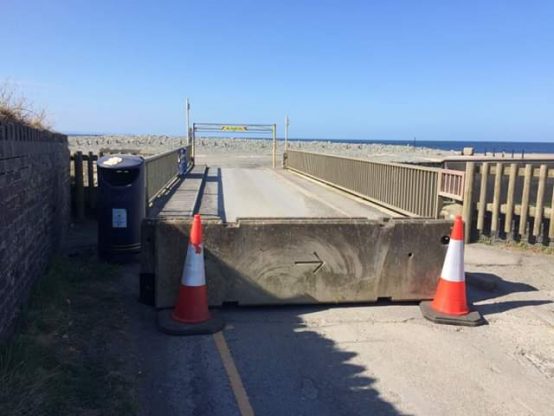
Concrete barrier at Tanybwlch beach
This is a large open areas where locals have always walked their dogs. There is ample space for social distancing. Indeed even without walking or sitting on the beach itself, ( both of which activities appear to be seriously frowned upon by the police) the stony bar above Tanybwlch beach is an ideal area for taking exercise. There are no seats to tempt successive sitters to risk contact with a virus particle left behind. There are no gates needing to be opened with by a potentially infected hand. I am reluctantly forced to conclude there is another aspect to the rules of lockdown. We should not be allowed to enjoy ourselves.
The Coronovirus Briefing on TV has just been followed by a Welsh Government Information Film. No Gatherings! No Beauty Spots! No Picnics! it thundered, these words obliterated with a big red cross like the no No Dog Shit signs of old. So that is the problem. Pendinas is beautiful. So they locked the gate.
How long will this situation persist? Obviously this is a question on the nation’s mind, and we have all accepted we are in the second three-week tranche of repression. But I was even more appalled to read in the papers today that Messrs Raab, Hancock, Gove and Sunak think it would be a good plan to relax lockdown for many but to visit these restrictions on the over 70s for a year or more! .. until a vaccine has been developed.
I recently joined this august age-cohort. We may be at somewhat greater risk of serious illness ( though now the preferred tag line “Anyone can get it” has replaced public acknowledgement of this fact!). But if infected, the greater likelihood is that, like the Prince of Wales, we may become unwell and get better in an unspectacular way.
Am I to be shut away for a year or more in order to avoid embarrassing the NHS by getting coronovirus? We septuagenarians need to rebel. Before I am roundly reproved for my selfishness, let me say I will be more than happy to commit to refusing to be put on a ventilator if I become seriously ill. I would either recover, or die more promptly, thus saving the NHS some money.
I think I speak for many when I say that what matters to me is not how many more years I have on the planet, but how many more healthy enjoyable years I get. And I will continue to climb over locked gates in order to enjoy myself, while social distancing, even in the shadow of the pandemic!
Life on Lockdown
by The Curious Scribbler
My dog and I have enjoyed some splendid walks in the last two weeks, happily all within my authorized orbit, accessible from my own front door.
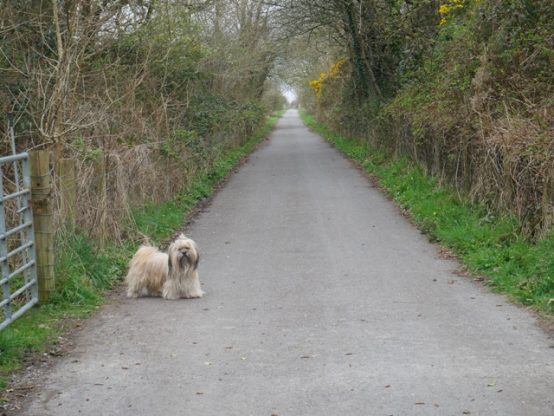
The spring has been heartbreakingly beautiful and every day brings new delights. A fortnight ago, the first chiff chaff appeared at Tanybwlch and within days the landscape became alive with them, belting out their monotonous song from tree tops and gorse bushes everywhere I walk. The wheatears are back in the stones below Alltwen, and stonechats and dunnocks everywhere in the scrub on the flanks of Pendinas. Woodpeckers drum in the alder trees by the cycle path and on several days there were no less than 35 choughs probing the sloping meadow on the foot on Pendidnas. I’ve seen kestrel, buzzard and kite overhead and a heron stalking the incipient salt marsh behind Tanybwlch beach. Today I also noticed that two Canada geese have taken up residence in the small pond below Tanybwlch mansion, and look as if they are planning on goslings. This pond has an island which will protect them from foxes. It is a historic feature in the landscape, formerly a public watering point on Tanybwlch flats, immortalized in old maps and a watercolour from the early 19th century.
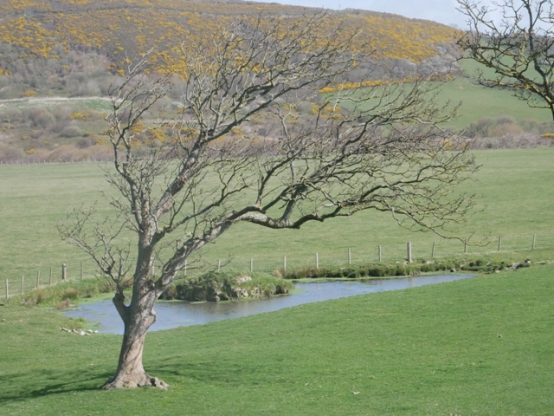
The watering hole below Tanybwlch mansion, now home to a pair of Canada Geese
The wildflowers are equally delightful, carpets of wood anemones in shady patches on the drive, celandines in the roadside banks opening their reflective golden petals in the sun, and a great drift of primroses on the bank facing the sea near where Lord Ystwyth built his tea cottage at the foot of Alltwen.
Only very occasionally does a jet aeroplane cross the blue vault of the sky, where formerly four of five could be seen simultaneously on any clear day. At night the consequences are obvious, the stars sharper and brighter, and venus gleaming like an unexpected streetlight over the hill. These are, as people often say to one another, strange times, but they are not short of natural beauty.
Also strange are the consequences of ‘social distancing’, the regime to which we must all strictly adhere and which has been interpreted fiercely since the new law was hastily put in place. First, I noticed that people became less inclined to the usual pleasantries, least they be thought to be socializing. Dog walkers usually say good day to one another, but now other walkers often pass silently, and on a few occasions even turn around to avoid passing me. Many familiar faces don’t seem to come along these paths at all, perhaps because they formerly drove to commence their walk. Tanybwlch beach has always been a prime spot for dog walkers but it is now rare to see more than a couple of dogs on the whole length of the strand.
Their place has been taken by cyclists and runners, many clad in bright bespoke costumes signifying their virtuous activity. Never before has there been such a succession of fit young men pounding along the strand and doing stretches, squats and press ups near the primrose patch, before pounding back towards the town. More worryingly though where are all the children? One day I saw a mother with her three children and a dog walking beside the Ystwyth, and another day I spied a father and his two small daughters with bikes on the cycle path. These though were rare sightings: far less than one might expect to see when all children are at home.
I do wonder whether we have gone too far with the virtue-signalling around reasons to be out of doors. Today the police posted a picture of South Beach, Aberysytwyth on Facebook. Taken at 2.20pm it was completely deserted, not a lone walker, not a dog, nobody at all. The post congratulates the people of Aberystwyth on not being there. This, apparently, is how our open spaces should look. Not social distancing but total absence is required.
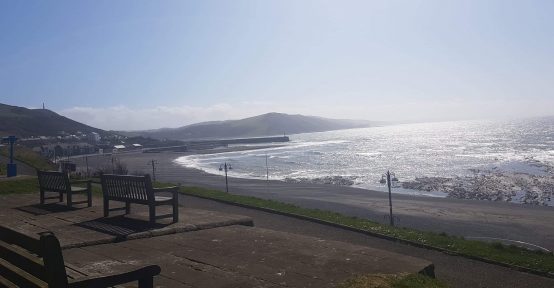
Heddlu DPPolice photo posted on Facebook
I’m glad I don’t live in the town. The promenade and the beaches are good places to walk and get some fresh air. Doing so, once a day, is not in fact a crime, yet possibly those who most need a walk and a breath of air now feel intimidated to do so.
Three thousand years of Archaeology
by The Curious Scribbler
I had an enjoyable day at the Morlan Centre in Aberystwyth on Saturday, at the Archaeology Day organized by the Dyfed Archaeological Trust. The remit of archaeologists today stretches from the very ancient to the extremely recent, and this was reflected in the range of talks. The morning started with the archaeology of yesterday while by the afternoon we were taken back three thousand years to the beginning of the first millienium BC.
Alice Pyper had been having fun exploring the archaeology of Llyn y Fan Fach, the glacial lake which now supplies Llanelli with a clean water supply. It was not always thus: the water system was built by conscientious objectors during the first world war. Some thirty of them were compelled to live in two drafty huts at 1200 feet above sea level to work on the project. Field archaeology involved excavating and recording the footings of these huts. Documentary sources including newspapers and humorous sketches by the objectors fleshed out the story. This workforce was of Englishmen who had already served time in prison for refusing to fight. Michael Freeman pointed out that in Wales objectors were less harshly treated, and that most of the thirty conscientious objectors in Ceredigion were not imprisoned and were allowed to keep their jobs.
Also representing the very recent past is the built heritage of the 20th century. Susan Fielding of the Royal Commission on the Ancient and Historical Monuments of Wales treated us to photographs of a splendid succession of architectural gems or carbuncles, some listed, others already demolished. The architects of the Percy Thomas Partnership ( familiar to us here for much of the Penglais Campus) kept cropping up, with Harlech College, Trinity Chapel at Sketty, and the soon-to-be-demolished Broadcasting House at Llandaff, all redolent of the 1960s. The Prestatyn Holiday Camp ( 1935) and the Rhyl Sun Centre (1980) have both gone, both extravagant expressions of their times, and dear to many people’s holiday reminiscences.

Rhyl Sun Centre by Gillinson Barnett & Partners
Source:Architectural Press/Archive RIBA Collections
The Shire Hall in Mold, dubbed Britain’s leading ugliest building, and the Wrexham Police station are brutalist buildings which will perhaps not be mourned too much. Still standing, and crying out for a role in a brooding TV Drama is Ysgol Syr Thomas Jones at Amlwch – one of the very first 1950s comprehensive schools.
Less is sometimes more, and it was strangely gratifying to learn from Clwyd-Powys Archaeologist Paul Belford that we really don’t know whether Offa’s Dyke has a great deal to do with King Offa, when it was built, or quite what it was for! Opportunities to excavate this world heritage site are few and far between, but one did arise from the actions of a Chirk man who bulldozed 50 yards of it in order to build a stable. ( His ignorance of its historic significance saved him from prosecution in 2014). Perhaps this vibe for vandalism is in the air around Chirk. Paul showed us a lidar image of the grounds of Chirk castle. In the 17th century Landscape Architect William Emes flattened much more than 50 yards of it to create smooth parkland, and submerged a further length of it in an ornamental lake!
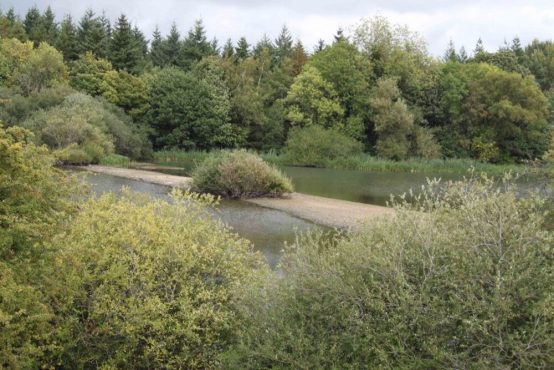
Low water levels in 2018 revealed Offa’s Dyke in the lake at Chirk Castle. Picture: The Shropshire Star
Two afternoon sessions concerned the days of the iron age hillfort, a period lasting from at least 1000 years BC. Hillforts are scattered like measles across the whole of the map of Wales, and with techniques of aerial photography and lidar more are still being discovered. Either they are on hilltops with ridge fortifications all the way round, or they are promontory hill forts, situated on the edge of a cliff or at the confluence between two valleys such that fortifications are not needed at the steeper sides. The archaeologists have been seeking evidence both within the enclosures, where groups of round houses were situated, and outside them where burials, and farming actvities took place. Ken Murphy rounded off the day with an account of the iron age chariot burial discovered last autumn in a field not far from a hillfort at an undisclosed location in west Pembrokeshire. Being buried along with your two wheeled chariot and your horse requires a pretty extensive hole and this type of burial is well known from East Yorkshire. The chariot burial discovered at the evocatively named village of Wetwang, revealed the human skeleton curled up between the wheels of his chariot, and the horse laid transversely at his head. The limey soil chemistry in east Yorkshire does not dissolve the bones.
In the Welsh burial bronze fragments of the bit, bridle and horse ornaments testifies to the horse, and an iron sword to the warrior, but their bones are long dissolved. The iron rims of the wheels and the imprint of the wooden chariot were found. These items are undergoing conservation at the National Museum of Wales and will then be put on display.
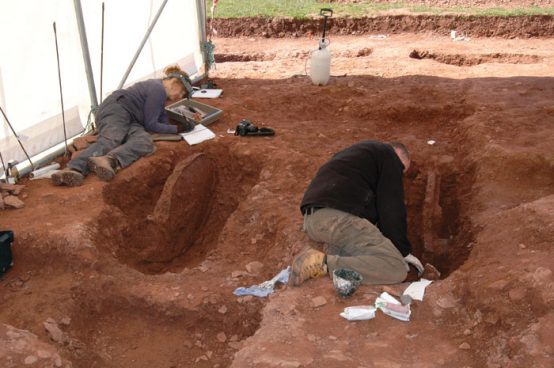
Photo credit: Archaeologists exposing the wheels of the Pembrokeshire chariot.
Amgueddfa Cymru – National Museum Wales
